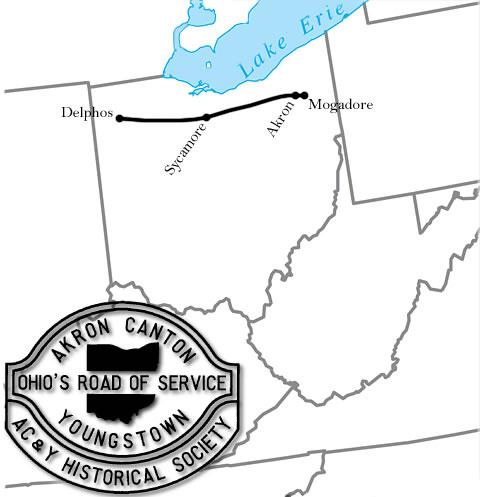A Brief History of the AC&Y

The Akron, Canton and Youngstown Railroad, which had its slogan, “Ohio’s Road of Service”, was a 171-mile single track railroad. It ran east-to-west from Mogadore to Delphos, across the northern tier of Ohio. Planned extensions to Canton and Youngstown were never built. Organized in 1907, the AC&Y began as a 7½-mile terminal operation, the vision of Akron industrialists Zeb Davis, H.B. Stewart, and F.A. Seiberling. The AC&Y was built to very high standards between 1911-1913. The rubber boom generated substantial new rail business. The road began operations with a fleet of five new Lima 0-6-0’s and a modest fleet of new freight cars.
Zeb Davis, H.B. Stewart, and F.A. Seiberling. The AC&Y was built to very high standards between 1911-1913. The rubber boom generated substantial new rail business. The road began operations with a fleet of five new Lima 0-6-0’s and a modest fleet of new freight cars.
In 1881, long before the incorporation of the ACY, the Cleveland Delphos and St. Louis was projected as part of a major narrow-gauge trunk line. Various changes in name, ownership and purpose ensued until the railroad was completed as the Pittsburgh, Akron and Western from Delphos, Ohio to Akron. In 1895, the line became the Northern Ohio, a subsidiary of Lake Erie and Western (then controlled by the NYC). The line was not successful and was considered the most superfluous railroad constructed in the State of Ohio.
In 1920, AC&Y absorbed the moribund Northern Ohio Railway thru a 999-year lease that created numerous western outlets, namely freight connections with the W&LE, B&O, C&O, NKP, DT&I, PRR, and NYC.
The Northern Ohio addition also furnished the AC&Y a 25% ownership interest in the Akron and Barberton Belt Line Railway, which served numerous industries in the Akron–Barberton freight district. The AC&Y and Northern Ohio formally merged in 1944.
Always well managed, efficient and financially viable, the AC&Y was recognized as the most profitable Class I railroad in the country during the 1920's. With prosperity came an upgrading of the Northern Ohio property and acquisition of new locomotives and rolling stock. Light 2-8-2 Mikes from the nearby Lima Locomotive Works became the standard road power. Alco-GE Switchers began to arrive around WWII. Mainline dieselization with F-M power began in earnest in 1948, and the last steam engines retired in 1955.
As a small railroad, the AC&Y competed successfully with the larger Eastern carriers like PRR, NYC, NKP, Erie, B&O, and C&O. The same roads were also valued connections.
The AC&Y was noted for excellent service including a daily mixed train operation. Roughly a third of AC&Y’s business was represented by highly competitive “overhead” or “bridge” freight traffic. The AC&Y-Northern Ohio offered 2nd a.m. service between Eastern points and St. Louis as part of the noted alphabet route with WM, P&WV, W&LE and the NKP.

In 1964, the AC&Y was merged into the N&W System. The Fairbanks-Morse diesels were gradually replaced by ex-NKP GP-7’s and N&W power. AC&Y was an independent operation until 1981 Norfolk Southern later sold the line to new interests. The remaining portion of the AC&Y east of Carey, Ohio is now operated as part of the Wheeling and Lake Erie.
Using 1969 as a representative statistical year, following are AC&Y freight car loadings by major commodity:
| Car Loading Commodity | Tonnage |
|---|---|
| Non-metallic mineral (including crushed and broken stone) | 27,556 |
| Bituminous coal | 11,646 |
| Chemicals and allied products (including synthetic rubber) | 11,176 |
| Rubber and plastic products (including tires and inner tubes) | 10,818 |
| Lumber and wood products | 3,383 |
| Food products | 3,302 |
| Stone, clay and glass products | 2,260 |
| Primary metal products | 1,746 |
| Transportation equipment | 1,414 |
| Petroleum and coal products | 1,187 |
| Forest Products | 1,346 |
| Farm Products | 810 |
Major AC&Y shippers included Youngstown Sheet & Tube, General Tire, Goodyear Tire & Rubber, Minnesota Mining (3M), Diamond Crystal Salt, Babcock & Wilcox, Columbia Chemical (PPG), H.W. Madison Pickle Company, National Lime & Stone, Wyandotte Stone, Central Ohio Electric Co-op, Ohio (beet) Sugar, United States Steel, Robinson Clay Products, Mohawk Rubber, Ball Brothers, B.F. Goodrich, Oglebay Norton, Rubber City Sand & Gravel, A.I. Root Company, Continental Baking, Firestone Tire & Rubber, Motor Wheel, Copperweld Steel, A.E. Staley and others.
The AC&Y was active in the secondary freight car markets. Much of its equipment roster consisted of second-hand cars. Long-standing relationships were formed with several major rail equipment lessors including Mather Patent Car Co. and A.A. Morrison (North American Car).